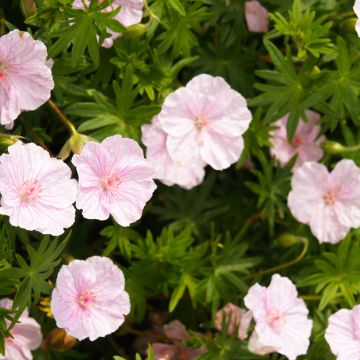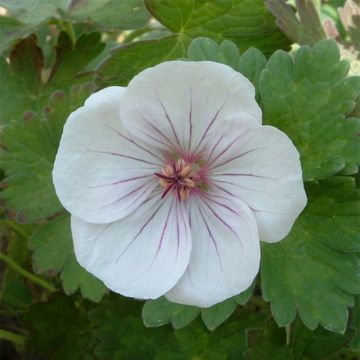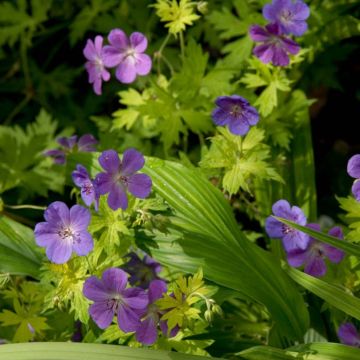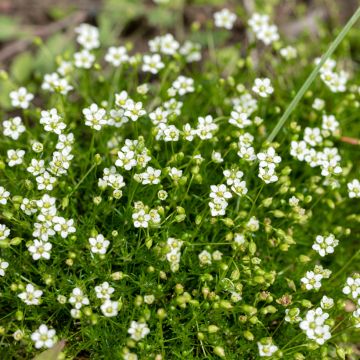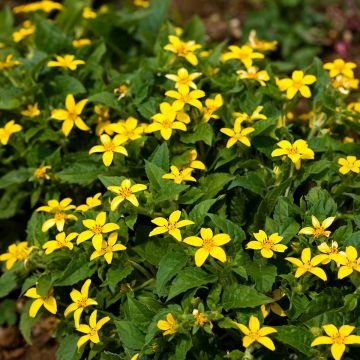

Geranium x sanguineum Anne's Family® Carol Anne - Bloody Crane's-bill
Geranium x sanguineum Anne's Family® Carol Anne - Bloody Crane's-bill
Geranium x sanguineum Anne's Family® Carol Anne
Bloody Cranesbill, Bloody Geranium
This item cannot be shipped to the selected country
Delivery charge from €5.90
More information
Schedule delivery date,
and select date in basket
This plant carries a 12 months recovery warranty
More information
We guarantee the quality of our plants for a full growing cycle, and will replace at our expense any plant that fails to recover under normal climatic and planting conditions.
From €5.90 for pickup delivery and €6.90 for home delivery
Express home delivery from €8.90.
Does this plant fit my garden?
Set up your Plantfit profile →
Description
The Anne's Family 'Carol Anne' Perennial Geranium is a particularly floriferous variety, with a well-covering vegetation, easy to cultivate. This plant tirelessly produces, for several months, beautiful flowers of a bluish violet colour veined with dark violet. It forms a beautiful carpet of leaves that spreads more or less as ground cover in sunny borders or even in semi-shaded areas of the garden. Versatile and undemanding, it also thrives in pots or hanging baskets, where it makes beautiful decorations for the terrace or balcony.
The Geranium Carol Anne belongs to the Geraniaceae family. This variety is part of a series of hybrids called Anne's Family, selected for their long-lasting flowering, comparable to that of 'Rozanne', as well as for their low requirements. It is a perennial herbaceous plant with a stump, whose vegetation remains more or less evergreen in winter, depending on the climate. It is probably derived from the Geranium sanguineum, among others. 'Carol Anne' has a semi-creeping habit, spreading to form semi-bushy mats 30-40 cm tall and at least 50 cm wide. It produces bluish violet flowers, approximately 4 cm in diameter, from May to October, without interruption. Its stems bear beautifully cut green leaves, which persist more or less in winter depending on the climate.
Why deprive yourself of such a ground cover with so many qualities? This Carol Anne perennial geranium grows enthusiastically in the sun, but also tolerates light shade. Hardy, it withstands cold and even damp weather down to -20 °C. This plant will establish itself permanently on a not too dry embankment or border a bed, a pathway, in the company of trouble-free perennials such as alchemilla mollis, Nepeta 'Six Hill Giant', heucheras, and of course the 'Rozanne' geranium. It is very useful for filling the base of old shrub roses, to which it will bring back summer interest. Its beautiful violet flowers are magnificent next to the purple foliage of the Physocarpus 'Midnight'.
Report an error about the product description
Flowering
Foliage
Plant habit
Botanical data
Geranium
x sanguineum
Anne's Family® Carol Anne
Geraniaceae
Bloody Cranesbill, Bloody Geranium
Cultivar or hybrid
Other Hardy Geranium - Cranesbill
Planting and care
To plant your Carol Anne geranium, prepare your soil by loosening it up to a depth of 20 cm and adding a slow-release fertiliser like blood, fish and bone at the bottom of the planting hole. Place your plant, removed from its pot, on top of the soil, making sure to cover the top of the root ball with 3 cm of soil. Fill in the hole and water generously to eliminate air pockets. During dry weather, it is important to water regularly for a few weeks to promote root growth. This hardy variety can tolerate a wide range of soils, including slightly acidic, neutral, heavy, or even chalky soils, as long as they do not dry out excessively. It prefers fertile, light soils that remain moist. Once established, it can go without watering in the summer in most regions, except during prolonged droughts and of course in the Mediterranean region.
Planting period
Intended location
Care
This item has not been reviewed yet - be the first to leave a review about it.
Summer flowering perennials
Haven't found what you were looking for?
Hardiness is the lowest winter temperature a plant can endure without suffering serious damage or even dying. However, hardiness is affected by location (a sheltered area, such as a patio), protection (winter cover) and soil type (hardiness is improved by well-drained soil).

Photo Sharing Terms & Conditions
In order to encourage gardeners to interact and share their experiences, Promesse de fleurs offers various media enabling content to be uploaded onto its Site - in particular via the ‘Photo sharing’ module.
The User agrees to refrain from:
- Posting any content that is illegal, prejudicial, insulting, racist, inciteful to hatred, revisionist, contrary to public decency, that infringes on privacy or on the privacy rights of third parties, in particular the publicity rights of persons and goods, intellectual property rights, or the right to privacy.
- Submitting content on behalf of a third party;
- Impersonate the identity of a third party and/or publish any personal information about a third party;
In general, the User undertakes to refrain from any unethical behaviour.
All Content (in particular text, comments, files, images, photos, videos, creative works, etc.), which may be subject to property or intellectual property rights, image or other private rights, shall remain the property of the User, subject to the limited rights granted by the terms of the licence granted by Promesse de fleurs as stated below. Users are at liberty to publish or not to publish such Content on the Site, notably via the ‘Photo Sharing’ facility, and accept that this Content shall be made public and freely accessible, notably on the Internet.
Users further acknowledge, undertake to have ,and guarantee that they hold all necessary rights and permissions to publish such material on the Site, in particular with regard to the legislation in force pertaining to any privacy, property, intellectual property, image, or contractual rights, or rights of any other nature. By publishing such Content on the Site, Users acknowledge accepting full liability as publishers of the Content within the meaning of the law, and grant Promesse de fleurs, free of charge, an inclusive, worldwide licence for the said Content for the entire duration of its publication, including all reproduction, representation, up/downloading, displaying, performing, transmission, and storage rights.
Users also grant permission for their name to be linked to the Content and accept that this link may not always be made available.
By engaging in posting material, Users consent to their Content becoming automatically accessible on the Internet, in particular on other sites and/or blogs and/or web pages of the Promesse de fleurs site, including in particular social pages and the Promesse de fleurs catalogue.
Users may secure the removal of entrusted content free of charge by issuing a simple request via our contact form.
The flowering period indicated on our website applies to countries and regions located in USDA zone 8 (France, the United Kingdom, Ireland, the Netherlands, etc.)
It will vary according to where you live:
- In zones 9 to 10 (Italy, Spain, Greece, etc.), flowering will occur about 2 to 4 weeks earlier.
- In zones 6 to 7 (Germany, Poland, Slovenia, and lower mountainous regions), flowering will be delayed by 2 to 3 weeks.
- In zone 5 (Central Europe, Scandinavia), blooming will be delayed by 3 to 5 weeks.
In temperate climates, pruning of spring-flowering shrubs (forsythia, spireas, etc.) should be done just after flowering.
Pruning of summer-flowering shrubs (Indian Lilac, Perovskia, etc.) can be done in winter or spring.
In cold regions as well as with frost-sensitive plants, avoid pruning too early when severe frosts may still occur.
The planting period indicated on our website applies to countries and regions located in USDA zone 8 (France, United Kingdom, Ireland, Netherlands).
It will vary according to where you live:
- In Mediterranean zones (Marseille, Madrid, Milan, etc.), autumn and winter are the best planting periods.
- In continental zones (Strasbourg, Munich, Vienna, etc.), delay planting by 2 to 3 weeks in spring and bring it forward by 2 to 4 weeks in autumn.
- In mountainous regions (the Alps, Pyrenees, Carpathians, etc.), it is best to plant in late spring (May-June) or late summer (August-September).
The harvesting period indicated on our website applies to countries and regions in USDA zone 8 (France, England, Ireland, the Netherlands).
In colder areas (Scandinavia, Poland, Austria...) fruit and vegetable harvests are likely to be delayed by 3-4 weeks.
In warmer areas (Italy, Spain, Greece, etc.), harvesting will probably take place earlier, depending on weather conditions.
The sowing periods indicated on our website apply to countries and regions within USDA Zone 8 (France, UK, Ireland, Netherlands).
In colder areas (Scandinavia, Poland, Austria...), delay any outdoor sowing by 3-4 weeks, or sow under glass.
In warmer climes (Italy, Spain, Greece, etc.), bring outdoor sowing forward by a few weeks.




































